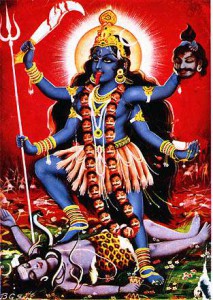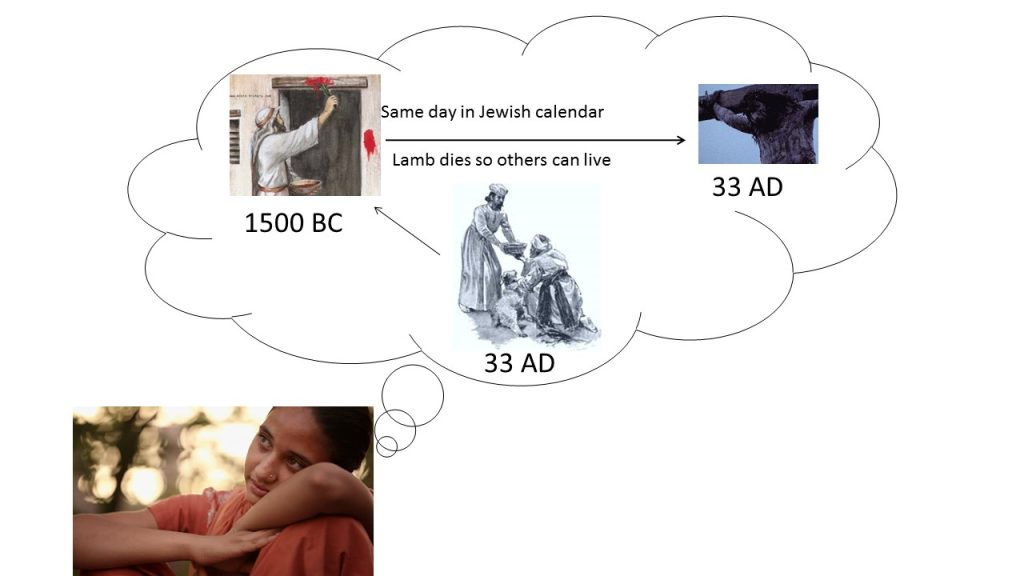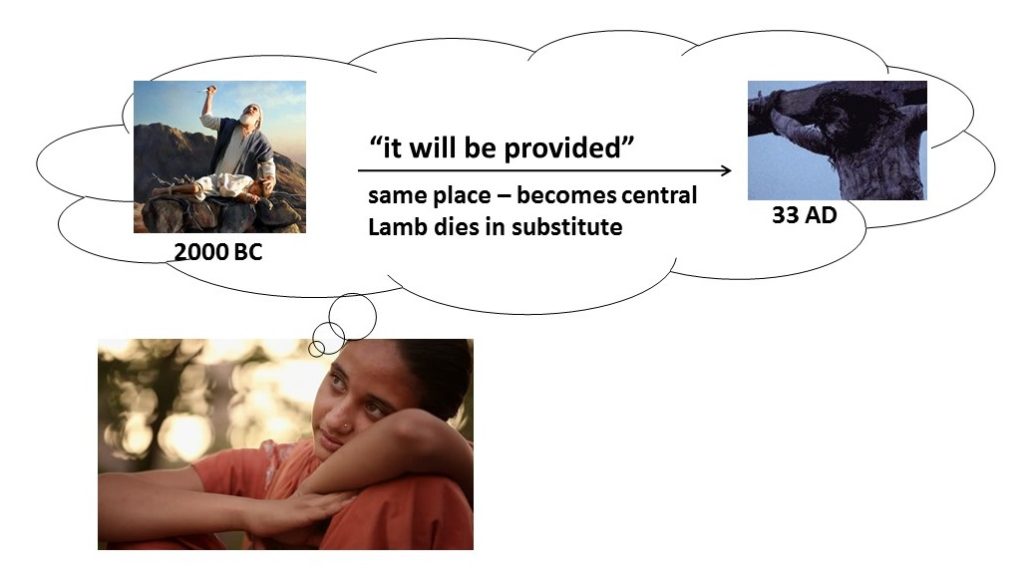Kali is usually known as the goddess of death, but more accurately comes from the Sanskrit word kal meaning time. Icons of Kali are fearsome because she is usually portrayed wearing a necklace of severed heads and a skirt of severed arms while holding up a blood-dripping, freshly-cut head, with one foot on the prone body of her husband Shiva. Kali helps us understand another story of death in the Hebrew Veda – The Bible.

Kali mythology recounts that the demon-king Mahishasura threatened war against the gods. So they created Kali from their essences. Kali savagely ripped through the ranks of the demon-army in a great bloodbath, destroying all who were in her path . The climax of the war was her battle with the demon-king Mahishasura whom she destroyed in a violent confrontation. Kali decimated her opponents into bloody body-parts, but she became intoxicated with all the blood so she could not stop her path of death and destruction. The gods were not sure how to stop her until Shiva volunteered to lay motionless on the battlefield. So it was when Kali, adorned with heads and arms of her dead opponents, put one foot on the prone Shiva and looked at him that she came back to her senses and destruction came to an end.
The Passover account in the Hebrew Veda mirrors this story of Kali and Shiva. The Passover story records an angel that, like Kali, brings about widespread death in opposing an evil king. This angel of death, like Shiva taking a vulnerable position to stop Kali, is blocked from any house where a helpless lamb has been sacrificed. Sages tell us that the meaning of this Kali story relates to the conquering of the Ego. The Passover story also has a meaning by pointing to the coming of Jesus of Nazareth – Yeshu Satsang – and his humility in renouncing his ego and sacrificing himself on our behalf. The Passover story is worth knowing
The Exodus Passover
We saw how Rsi Abraham’s sacrifice of his son was a sign pointing to the sacrifice of Jesus. After Abraham, his descendants through this son Isaac, called Israelites, had become a vast number of people but also slaves in Egypt.
So we now come to a very dramatic struggle taken up by the Israelite leader Moses which is recorded in the Hebrew Veda of Exodus in the Bible. It records how Moses led the Israelites out of Egyptian slavery 500 years after Abraham, around 1500 BCE. Moses had been commanded by The Creator to confront the Pharaoh (ruler) of Egypt and it resulted in a conflict between the two which had brought nine plagues or disasters on Egypt. But Pharaoh had not agreed to let the Israelites go free so God was going to bring about a 10th and final plague. The complete account of the 10th Plague is here.
God decreed that for the 10th plague an Angel (Spirit) of Death would pass through all houses in Egypt. Every firstborn son in each house across the entire land would die on a specific night except those who remained in houses where a lamb had been sacrificed and its blood painted on the doorposts of that house. Pharaoh’s doom, if he did not obey and paint lamb’s blood on his door, would be that his son and heir to the throne would die. And every house in Egypt would lose the firstborn son – if the blood of a sacrificed lamb was not painted on the doorframes. Egypt faced a national disaster.
But in houses with a lamb sacrificed and its blood painted on the doorposts the promise was that everyone would be safe. The Angel of Death would pass over that house. So that day was called Passover (since death passed over all houses with lamb’s blood painted on them).
The Passover Sign
Those who have heard this story assume that the blood on the doors was a sign for the Angel of Death. But notice the curious detail taken from the account written 3500 years ago.
The LORD said to Moses … ” … I am the LORD. The blood [of the Passover lamb] will be a sign for you on the houses where you are; and when I see the blood, I will pass over you. (Exodus 12:13)
Though God was looking for the blood on the door, and when He saw it Death would pass over, the blood was not a Sign for God. It says quite clearly, that the blood was a ‘sign for you’ – the people. It is also a Sign for all of us who read this account. But how is it a sign? Afterwards the LORD commanded them to:
Celebrate this day as a lasting ordinance for generations to come. When you enter the land … observe this ceremony… It is the Passover sacrifice to the LORD’ (Exodus 12:27)

The Israelites were commanded to celebrate Passover on the same day every year. The Jewish calendar, is a lunar calendar like the Hindu calendar, so it is a little different from the Western calendar, and the day of the festival changes each year by the Western calendar. But to this day, 3500 years later, Jewish people continue to celebrate Passover as a festival on the same date of their year in memory of this event and in obedience to that command given then.
Passover Sign pointing to the Lord Jesus
In tracking this festival through history we can note something quite extraordinary. You can notice this in the Gospel where it records the details of the arrest and trial of Jesus (1500 years after that First Passover plague):
Then the Jewish leaders took Jesus from Caiaphas to the palace of the Roman governor. By now it was early morning, and to avoid ceremonial uncleanness they did not enter the palace, because they wanted to be able to eat the Passover. (John 18:28)
But it is your custom for me to release to you one prisoner at the time of the Passover. Do you want me to release ‘the king of the Jews’?” (John 18:39)
In other words, Jesus was arrested and sent for crucifixion right on the Passover day in the Jewish calendar. One of the titles given to Jesus was
The next day John (i.e. John the Baptist) saw Jesus coming toward him and said, “Look, the Lamb of God, who takes away the sin of the world. This is the one I meant when I said ‘A man who comes after me has surpassed me because he was before me’”. (John 1:29-30)
Here we see how the Passover drama is a Sign to us. Jesus, the ‘Lamb of God’, was crucified (i.e. sacrificed) on the very same day of the year that all the Jews were sacrificing a lamb in memory of the first Passover that had occurred 1500 years before. This explains the annual timing of two holidays that re-occurs every year. The Jewish Passover Festival occurs almost every year at the same time as Easter does – check a calendar. (Every 19th year there is a divergence of a month due to the cycle of lunar-based leap years in the Jewish calendar). This is why Easter moves every year because it is based on Passover, and Passover is timed by the Jewish calendar which calculates the year differently than the Western Calendar.
Now think for a minute about what ‘signs’ do. You can see some signs below here.
A Sign of India
The flag is a sign or symbol of India. We do not ‘see’ just a rectangle with an orange and a green band across it. No, we think of India when we see the flag. The sign of the ‘Golden Arches’ makes us think about McDonalds. The ‘√’ sign on Nadal’s headband is the sign for Nike. Nike wants us to think of them when we see this sign on Nadal. Signs are pointers in our minds to direct our thinking to the desired object.
The Passover account in the Hebrew Veda of Exodus explicitly said that the Sign was for the people, not for Creator God (though He would still look for the blood and pass over the house if he saw it). As with all signs, what did He want us to think of when we look to Passover? With the remarkable timing of lambs being sacrificed on the same day as Jesus, it is a pointer to the sacrifice of Jesus.
It works in our minds like I show below. The sign points us to the sacrifice of Jesus.

In that first Passover the lambs were sacrificed and the blood spread so the people could live. And thus, this Sign pointing to Jesus is to tell us that he, ‘The Lamb of God’, was also given as a sacrifice to death and his blood spilt so we could receive life.
In the Sign of Abraham the place where Abraham was tested with the sacrifice of his son was Mount Moriah. A lamb died so Abraham’s son could live.

Mount Moriah was the very same place where Jesus was sacrificed. That was a Sign to make us ‘see’ the meaning of his death by pointing to the place. In the Passover we find another pointer to Jesus’ sacrifice – by pointing to the same day in the year. A lamb sacrifice is once again used – showing that it is not just a coincidence of an event – to point to the sacrifice of Jesus. In two different ways (through location and through timing) two of the most important festivals in the sacred Hebrew Vedas directly point to the sacrifice of Jesus. I cannot think of any other person in history whose death is so foreshadowed by such parallels in such dramatic fashion. Can you?
These signs are given so that we can have confidence that the sacrifice of Jesus really was planned and ordained by God. This was to give an illustration that helps us visualize how the sacrifice of Jesus saves us from death and cleanses us from sin – the gift from God to all who will receive it.